MULTIVEN - The First and Only Decentralised Provider for All Blockchain Nodes
It is a David and Goliath situation. Only this time there is more at stake than a nation-state: it is the blockchain world and Bitcoin itself. It is acknowledged that only a tiny percentage of people globally use cryptocurrencies. It is also an acknowledged fact that the majority of the status quo is very uneasy about a technology, and means of exchanging value, that has the capacity to by-pass central authorities, large corporates and even governments.
Taking on a challenge is not something that frets Peter Alfred-Adekeye. A former Cisco Technical Leader who left the firm in 2005 to set up his own Internet network software maintenance and cyber-defence company. From its inception, his Pingsta platform was set up as a decentralised, socially intelligent network to help solve complex software, security and cryptographic problems that impact the Internet.
With a vision that largely anticipated Satoshi Nakamoto’s 2008 whitepaper, Alfred-Adekeye outlined a view that would see talented engineers, software developers, cyber experts, cryptographers and futurists invited to join his platform. He understood that many talented IT people did not want to belong to corporates or valued their independence.
He hand-picked some of the smartest networking engineers available and soon built up a network of 1200 experts. However, he also managed to secure the interest of some elite professionals including Dr Lawrence Roberts, designer of the ARPAnet in 1967, Tony Li, co-inventor of the Border Gateway Protocol BGP4 and the late renowned cryptographer Hal Finney, who some believe was Satoshi Nakamoto himself. Hal joined in 2007 as member number 62.
Alfred-Adekeye’s first challenge lay in the corporate world. In his new company, Multiven sold network software maintenance services and tapped the on-demand expertise of Pingsta members to deliver upon the services. Customers would create tasks that would be intelligently assigned by mySolvr, Multiven’s AI-engine, directly to engineers (some of whom also acted as TAC duty managers) with subject matter expertise, who resolve the client issue, while maintaining the highest service levels.
However, he was frustrated in that, any work tendered that included Cisco networking equipment, met with resistance. This is an issue because some 75% of all internet networks run over Cisco equipment. He discovered at the same time that Cisco was wrongfully forcing customers to buy its expensive service contracts in order for them to get software updates that correct defects created by Cisco. Most large companies felt compelled to take out these expensive service contracts to ensure bug fixes were readily available. What they did not realise was that Cisco was reducing its software quality assurance to maintain customer compliance. As Cisco software is not open-source, only Cisco can fix issues in its software.
On December 1, 2008, Multiven, under Alfred-Adekeye’s leadership, filed a US antitrust legal action to expose this fraudulent behaviour and abuse of dorminant power. However, Cisco reverted with some very questionable actions that led to Alfred-Adekeye being arrested on Cisco-fabricated counter-claims, during Multiven’s antitrust hearing in a US court sitting in Canada and detained for 28 days. After the initial shock, he realised he needed to be both patient and strong.
“I needed to take leaf out of Nelson Mandela’s book if I was to succeed,” he says. Cisco and indeed the US authorities were found to have acted in a very illegal fashion. Alfred-Adekeye was released and his legal action was ultimately successful.
“This victory was important for reasons other than just pure justice,” he explains. “The fact that 75% of all Internet communication goes through Cisco devices, essentially places an overwhelming majority of the Internet infrastructure along with all our private, corporate and blockchain traffic, under the control of a single actor, Cisco”
Alfred-Adekeye goes on to explain. The internet comprises of software-driven networked switches, routers, firewalls, servers and storage hardware that switch, route, protect and store all our voice, video, text and blockchain data from our smartphones, tablets and computers intelligently across the world. The Internet is also the infrastructure that connects all blockchain nodes, and upon which all blockchain traffic traverses. Accordingly, its availability, reliability and security to all cryptocurrencies and decentralised applications cannot be over-emphasised.
“Therefore, it can be concluded,” says Alfred-Adekeye. “That without the Internet, there is no Blockchain; Without Internet-connected computers called “Nodes”, that relay, validate and irrevocably record transactions on memory blocks that are chained together cryptographically, there will be no cryptocurrencies like Bitcoin.
“And, as the de-facto reserve currency for the broader cryptocurrency economy, without Bitcoin, all other cryptocurrencies will lose credibility and drop in value.”
“We need to protect the Internet and all public blockchain nodes. Right now there are 12,000 active nodes supporting the Bitcoin blockchain and just under 18,000 nodes supporting the Ethereum blockchain. However, these are predominantly located in the US and Europe. There are literately only a handful of nodes in South East Asia, Africa and Latin American.
“This leaves Bitcoin geographically vulnerable to centralization attacks and we cannot allow this to happen.”
Alfred-Adekeye’s vision is two-fold. Deploy the elite experts on his Pingsta platform onto the blockchain, to harden the cyber-defenses of Bitcoin and other public blockchain nodes. This will be a free service for all public blockchain node operators and the experts will be compensated in MultiCoin.
He is also building a blockchain-based marketplace — like Amazon — but for IT equipment and services that will be considerably cheaper than conventional e-commerce marketplaces.
“That way, people wishing to operate Bitcoin nodes in those neglected parts of the world would be able to purchase cheaper equipment which will lead to further decentralisation. Currently Bitcoin and Ethereum are not decentralized proportionately across all geographies,” he says.

The Multiven Open marketplace will enable everybody to buy and sell computer and network products and services on a peer-to-peer basis, enforced by smart contracts, with no intermediaries.
The sole medium of exchange is the Multiven Coin — MultiCoin (MTC) and both buyers and sellers in the Multiven marketplace will need to have MultiCoins as proof-of-stake for transactions. In addition, as products change hands, the Multiven marketplace will immutable maintain a proof-of-ownership record for all products, on the blockchain that may be tapped in future by other DApps as an Oracle.
“The origin of commerce is physical, and with the Internet came electronic commerce. Commerce on the blockchain via the Multiven Open Marketplace represents the next wave and the prelude to the final frontier of AI-to-AI commerce, where bots will transact on our behalf” he says.
Alfred-Adekeye quotes an example of a fridge automatically ordering groceries, via smart contracts, as it empties from the store and paying in cryptocurrencies as bots don’t have bank accounts”
Core to his world view of maintaining Bitcoin as a strong base currency, Alfred-Adekeye has also changed his crowdfunding model. “Nowadays ICOs sell up to 85% of their tokens in the private pre-sale stage to big institutional funds. Centralization of tokens, nodes or anything else for that matter, is directly opposed to Satoshi Nakamoto’s view of the world.”
Accordingly Multiven has no pre-sale. The full public ICO crowdsale is currently live and will run for 75 days. The hard cap is €100 million. However, it favours the small investor. The first round is capped at a maximum of 1000 Ether per contributor, the second round reduces to 500 Ether, the third round is 250 Ether and last round is capped at 50 Ether.
“We do not want a handful of big investors to come in and buy up all our tokens and for the masses to have to pay a premium to get them after the crowdsale,” he says. “We want to democratise the sale and ensure a decentralized token distribution. This way, we can create a marketplace that is genuinely open and accessible to everybody.
“And a portion of the transaction fees in the MOM will be used to reward the decentralized network and security experts that are monitoring and defending Bitcoin nodes and their Internet gateways against cyberattacks.”
Looks like Alfred-Adekeye is eyeing up the next big challenge to make the world a better place. And was Pingsta member number 62 Hal Finney the real Satoshi Nakamoto? And is that what sparked the white paper of 2007?
Multiven
Multiven become first and only provider of independent, decentralised and politically-neutral software integrity maintenance and cyber-defense services for all the blockchain nodes and hardware that make up the world’s internet network in the world. Defending Bitcoin and public blockchain network nodes against cyberattacks, powered by the world’s first blockchain-based open marketplace for IT hardware, software and services. Multiven create the world’s first blockchain based marketplace and powered by smart contract.
For use as a distributed ledger, a Blockchain is typically managed by a peer-to-peer network of computers called Nodes, that relay, validate and record transactions onto memory blocks.

Multiven is taking the unprecedented step of expanding the Bitcoin node network into space by using some of the proceeds of this token sale, to fund the research, development, design, launch, monitoring and maintenance of low-Earth orbiting space-based nodes.
NODES-IN-ORBIT (NiO)

To achieve its mission for NiOs, Multiven will collaborate with, amongst others, the
InterPlanetary Networking Special Interest Group (IPNSIG)
Multiven Aims
- Harness and deploy decentralized human-powered artificial intelligence towards defending Bitcoin.
- Maintain the integrity of the software that runs all other non-Blockchain Internet networks globally.
- Document and map every device (type, geo-location, owner etc.) on the Internet (hardware and software) and make them globally available on the blockchain.
- Launch the Multiven Open Marketplace (“MOM”), the world’s first blockchain-based marketplace that will simplify and lower the cost of buying, selling, and sharing of computer and network hardware, software and services between businesses and consumers using Multiven Coins, on a peer-to-peer basis, without intermediaries.
- Design, launch and maintain active Bitcoin full Nodes-in-Orbit (“NiO”) to serve as a spatial extension of the global node network that will be out of reach of earthly adversaries.
Technology Approach
Delay Tolerant Networking — Key Protocol Components — RFC4838
Delay/Disruption Tolerant Networking (“DTN”)is an end-to-end architecture and an evolution of the architecture originally designed for the Interplanetary Internet, a communication system envisioned to provide Internet-like services across interplanetary distances in support of deep space exploration. The DTN architecture provides a framework for routing and forwarding at the bundle layer for unicast, anycast, and multicast messages.
Contact Between Nodes
Contacts between nodes fall into the following categories;
- Persistent Contacts
- On-demand Contacts
- Intermittent or Scheduled Contacts
- Intermittent — Opportunistic Contacts
- Intermittent — Predicted Contacts
The multiven goals can be visualized like bellow

Multiven is 100% employee-owned with no institutional investors, zero bank debt, millions in revenue and a 9-figure active service sales pipeline.
The Current Live Multiven Platform Dashboard
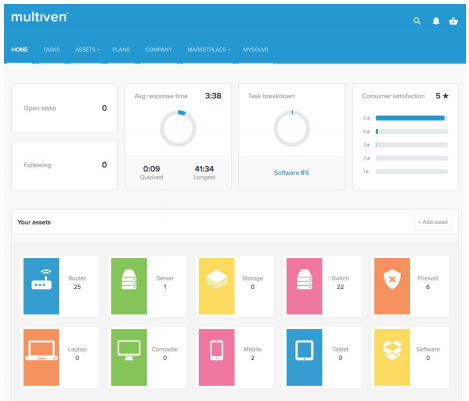
Multiven Services
Multiven Pearl
A multivendor network hardware and software maintenance service for all Internet enabled devices e.g. routers, switches, firewalls, servers etc
Multiven Pearl Guard
A network-based cyber-defense product that neutralizes cyberattacks and restores affected services within 24 hours.
Multiven Open Marketplace
The world’s first Blockchain-based open marketplace for new, used and decommissioned computer network hardware, software and services powered by MultiCoin tokens.
Multiven Oyster
A Multiven proprietary computer and network hardware and software asset management, collaboration and mapping application.
Multiven Business Model Transition Post ICO
Multiven was founding because there is some problem around the the way the world buy’s, maintains and sells their computer and network equipment install-base. That problem become secondary mission of Multiven.
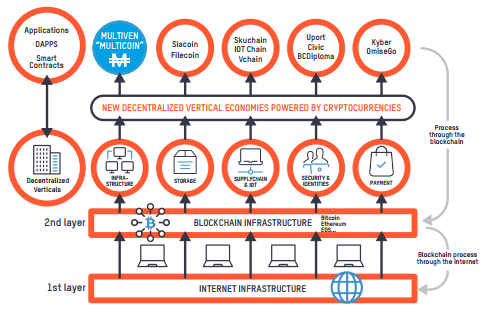
Multiven Clients Post ICO
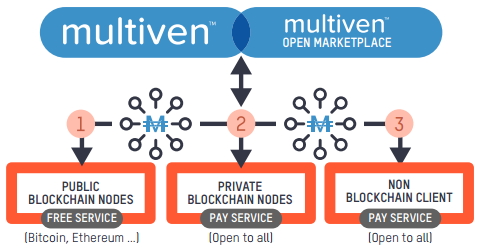
Marketplace Smart Contracts
Through its marketplace, Multiven is targeting two types of markets:
First hand/Brand new market
is currently centralized around a handful of equipment manufacturers (Hardware and Software) selling hardware and software licenses, at dictated prices, only via a handpicked selection of channel “distributors” who sell to “authorized resellers and partners” who in turn sell to corporate, retail, government and Telecom companies.
Second hand market
s on the other hand disorganized, passing through a very large number of independent resellers and brokers. The market has in fact remained untapped due to the absence of an innovative sales channel, connecting parties to buy and sell equipment. Additionally, most medium to large corporate firms and Telecom companies have a high inventory of decommissioned, unused/like-new or unwanted hardware (router, switch, server, processor etc) and software, all available to be monetized.
The Multiven Open Marketplace — MOM Ecosystem
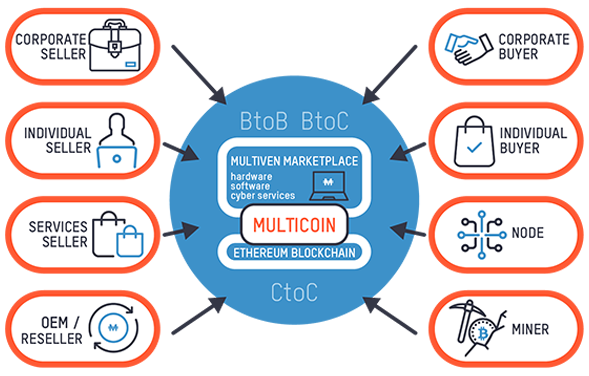
Token
Token : MTC
Price : 1 MTC = 0.5 EUR
Bonus : Available
Platform : Ethereum
Accepting : ETH
Soft cap : 10 000 000 EUR
Hard cap : 100 000 000 EUR
Country : Switzerland
Whitelist/KYC : Whitelist
Restricted areas : USA
ICO Structure
The multiven ICO is live now. Its your time to take a part of thi platform. from this platform you can get so much benefit . The 200M or 10% MultiCoin — ERC-20 Tokens will be sold in the following manner:
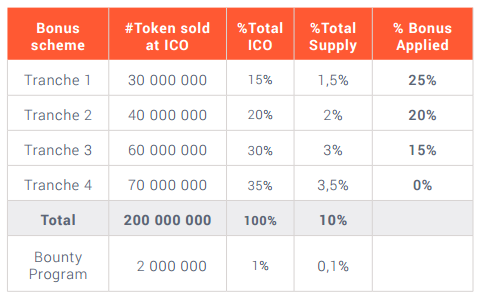
Use Of The ICO Proceeds
Sources & Uses
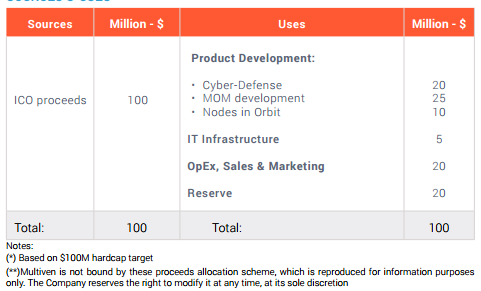
Multiven “Incentive program” will be activated at the same time the marketplace goes live. All device profiles will be saved on the Blockchain (specifically, the constant data e.g. device part number, serial number etc. will be hashed and saved off-chain and linked to the variable data e.g. geo-location, ownership, etc. which will be saved on-chain) creating a Back-up of the Internet infrastructure global install-base.
Multiven will allocate 200M MultiCoins (10% of the MultiCoin Supply) to the incentive program which will be released in the following manner:

MultiCoin is the sole medium of exchange on the Multiven Open Marketplace (MOM)
Team

Advisors
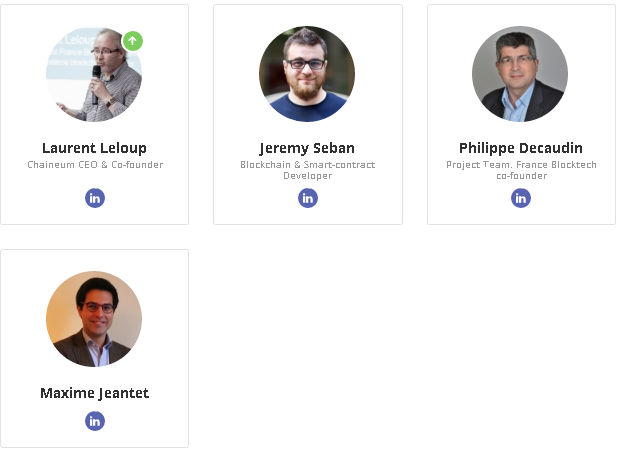
FOR MORE INFORMATION :
Website: https://multiven.io/Whitepaper: https://multiven.io/wp-content/uploads/2018/03/Multiven_WP-Final.pdf
Facebook: https://www.facebook.com/MultivenGroup/
Twitter: https://twitter.com/multivengroup
Telegram: https://t.me/MultivenOfficialGroup
AUTHORSHIP BY Liana Kurniawan
My Bitcointalk profil : https://bitcointalk.org/index.php?action=profile;u=1352447




Komentar
Posting Komentar